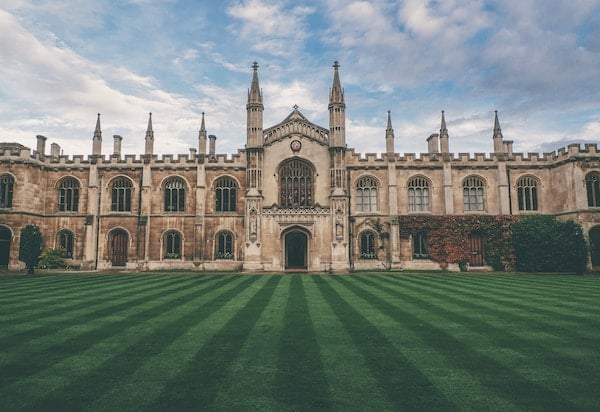Published on
The Third Wave: Overcoming Elitist College Rankings

The American higher education system was designed around creating economic mobility and access for individuals of limited means, underpinned by the notion that the more educated a society was, the stronger it would be. Unfortunately, over the past few decades institutional rankings designed to push universities to replicate the models that work for a small number of elite universities have become ubiquitous, and with those rankings the public understanding of what makes a postsecondary institution “good” has evolved too.
In this interview, Paul Glastris discusses the origins of these rankings, as well as their value (and consequences) and shares his thoughts on how the structure of institutional rankings needs to evolve to create a postsecondary ecosystem that serves modern learners’ needs.
The EvoLLLution (Evo): Why are college ranking lists in general important, especially for non-traditional learners?
Paul Glastris (PG): People make sense of the quality of things (be it their cars or restaurants) in an ordinal fashion, following rankings. It’s how human beings best absorb measures of quality. And you can take issue with any ranking in an intellectually honest way by saying, “Well, the difference between number 14 and number 15 is di minimis, so why rank at all?” That’s fair, but what overwhelms that criticism is the usefulness of rankings in quickly conveying the results of a measure of quality.
Evo: What are some of the most significant issues with traditional college rankings that tend to highlight factors that speak to sort of prestige and exclusivity?
PG: The dominant player in the rankings business has long been and remains US News and World Report (my old employer). We created the Washington Monthly’s rankings as a direct challenge to US News and World Report because we think their metrics are a form of alchemy. They claim to classify schools as “the best” but they do so in the absence of actual measures of learning outcomes, which don’t exist. What they look at are proxy measures of exclusivity, wealth and fame. This reflects and accentuates the accepted hierarchy in higher education, which is that schools like Harvard, Stanford and Yale are obviously the best, so their attributes should set the standard for all of higher education.
But if every college aims to rise on the US News rankings (and they all desperately want), then what happens to the American higher education sector? It becomes more exclusive, more expensive and more brand prestige oriented. College presidents decide to raise their SAT score requirements in order to rise in the rankings. That leaves other schools to educate the 90% of students who have neither the SAT scores nor the money to go to these elite universities but need a college degree for a middle-class life.
Additionally, the current ranking structure leads federal and state lawmakers to make budget decisions that cater mostly to the white upper middle class. As a result, the institutions that are highly ranked and serve this demographic, wind up getting budgeted by their governments to spend twice as much per pupil than community colleges, which are disproportionately serving lower income and minority populations.
The whole value set unpinning traditional ranking systems affects higher education in a way that is anti-democratic and creates more inequality.
Evo: How did Washington Monthly get involved with rankings?
PG: We created the Washington Monthly Rankings to be an antidote to that set of values. We asked ourselves what we can honestly measure that reflects the values of most Americans, and especially of taxpayers who are forking out $180 billion a year in federal spending for student aid. What set of metrics would lead to a higher education system that promoted more prosperity, more equality and more democracy?
We came up with three basic measures:
1) Upward Mobility
These are a handful of metrics that assess whether a college recruits and graduates students of modest means, and whether it charges a reasonable amount for tuition while delivering a credential that generates a decent earning for that student.
2) Research
It’s a measure of the degree to which the college or university creates scholars and scholarship that drives economic growth and human flourishing.
3) Service
This measures the extent to which colleges encourage students to give themselves to their country and community, to be active citizens. It looks at the percentage of students who enlist in ROTC (the U.S. military’s college-based officer training program), who go on to enlist in the Peace Corps, and the number of work-study slots–federal money given to universities and colleges for student jobs–set aside for community service work as opposed to cheap labor for the university.
We’ve also recently added a new measure of the extent to which a college or university encourages their students to vote.
On those measures, we get quite dramatically different results than US News.
Evo: What are the characteristics of the higher education environment that US World and News is trying to create compared to what Washington Monthly is trying to create?
PG: The US News College Ranking was created by Ivy League educated journalists and editors based on their own experiences. It was self-evident that Harvard, Yale, Stanford, Princeton and Dartmouth were the best schools. So the rankings put everyone in a preexisting preference. They’ve tried to back off a little. Last year was the first time they added measures of upward mobility, very similar to what we do, and I congratulate them on that, but it’s a very small portion of their overall metrics. It’s clear they’re under pressure to reconceive of the traditional hierarchy.
Ours is meant to measure how well colleges do with whatever qualifications and backgrounds students have. U.S. News and most other ranking systems reward colleges for excluding students who don’t have high scores on admissions tests like the SAT. In practice this rewards colleges that recruit mainly from affluent high school that prepare their students better. A school that recruits from lower-income high schools is almost by definition penalized. The Washington Monthly doesn’t factor in SAT scores or admissions rates in its ranking at all. In fact, we give colleges extra credit for letting in more non-wealthy students. And colleges earn extra points if, in comparison to schools with similar demographics, its students pay a lower net price, graduate at higher rates and earn more in their careers. The aim is to encourage colleges and universities to become great places of learning for whichever students they happen to be serving.
Evo: Is it possible to have a ranking system that adequately represents each institution on their own terms? Or do we need to recognize that, as we have a great diversity of postsecondary institutions, so must we have a diversity of ranking and grading mechanisms?
PG: I would say that the answer to that question rests on whether there are measures of outcomes that we can all agree on. For example, if we can agree that a student who starts higher education should finish with a credential of one sort or another, then graduation rates matter regardless of the program.
Evo: How do you see the college ranking industry evolving in five to 10 years, as student demographics, institutional competitive realities and public pressure continue to evolve?
PG: Jim Fallows of The Atlantic Monthly, who was the editor of US News, writes a lot about rankings. His argument is the more rankings, the better. There’s no one ranking system that captures the complexity of something as gargantuan and diverse as higher education. But that doesn’t mean you abandoned the attempt. It means you take numerous stabs at it. It’s like mapping a mountain range, you need a lot of data points. You cut a lot of paths through that range and try to get as granular a view as you can. So, as more outlets take a stab at this and as more data becomes available, a clearer picture will emerge. I think we’re already seeing that.
Secondly, how the ranking industry changes rests on how public policy changes. By that I mean, state governments control the budgets of their public colleges and universities. Many of them have instituted performance-based budgeting whereby the government sets up metrics they want their universities to meet. If they meet them, they get extra money, if they don’t then they get a cut. In a lot of cases now, those performance-based budgeting regimes factor in the same issues and values that we do at the Washington Monthly.
It’s difficult, but not impossible, to rank colleges based on what’s best for non-traditional students. We’ve tried to do that with our Best Colleges for Adult Learners ranking. In that ranking, we measure factors such as whether a college schedules classes in the evenings and on weekends, which is when adults have the time to attend classes; whether it allows easy transfer of credits that one might have earned at one or more other institutions years ago; whether it gives credit for skills and knowledge gained on the job; or whether it offers services such as on-campus daycare. All of these factors go into to our measure of colleges that do right by adults. And that’s based on new data that we just happen to have acquired. So, as the government makes more data available, you’ll see new and better ranking systems.
Evo: How do you see non-credit programming beginning to play a more central role in the development or ranking of quality, of outcome impact for nontraditional and working adults?
PG: It’s very difficult when you don’t have reliable data to do a ranking. There are a lot of non-credit certifications out there and we know from studies that their quality ranges widely. Last year, we published the first ranking of the best vocational certification programs and we did that by tapping a dataset that no one had ever used for that purpose. It’s a dataset that comes out of the gainful employment rule, an Obama administration measure that was meant spotlight vocational type programs at both public, private and nonprofit institutions. So, we took the 12 most common vocational paths (auto mechanics, health aids, HVAC repair, welding, etc.) and ranked all the providers of those certificates based on outcomes measures, specifically earnings. It was astonishing what we found.
On the one hand, there are some particular lines of work like welding, auto mechanics and HVAC that lead to fully middle-class incomes when provided by certain schools. On the other hand, there are providers of those same certificates that lead to incomes that are significantly below the minimum wage. Meaning those certificates are not just worthless, they’re poisonous, right? They’re leaving their students with a certificate that’s not worth anything in the marketplace, and a lot of debt. So that was our stab at trying to build a ranking around non-traditional, non-diploma based higher education. Alas, the Trump administration choked off that data. So again, I think the answer is the more data, the more potential to rank.
Evo: Is there anything you’d like to add about the transforming postsecondary ecosystem and the role of rankings in pushing that evolution onward?
PG: We’re in the middle of the third transformation of American higher education. Higher education, both by its origins and in many ways its inclination, tends to be about educating a minority, the select, the college man, somebody who’s college material. These are all phrases that used to be quite common. And in America, the first colleges for the first 75 years of the country’s existence trained exclusively the sons of prosperous merchants, aspiring lawyers and pastors.
During the Civil War, the first great wave of egalitarian reform happened with the passage of the Morrill Act, which created the Land-Grant College and programs to help people like farmers and mechanics learn how to improve their practices to keep up with the realities of an industrializing society. That broad-based higher education effort was quite revolutionary in human history.
We had another great wave during World War II and in the decade or so after, when the GI Bill provided college education for free to returning veterans. While many institutional leaders were in favor of this commitment to access, the president of University of Chicago at the time feared that all these veterans would turn universities into what he called “intellectual hobo jungles.” But instead, we had the creation of the first mass middle-class and other legislation under the Johnson administration that essentially democratized access to higher education.
Since then, higher education has gone the other way. It’s retrenched as an elitist sector that rewards the best prepared and wealthiest among us and then under-invests and underserves everybody else. But we’re seeing pressure for a third wave of egalitarian reform in this country. Organizations like the Lumina Foundation, The Gates Foundation, The Washington Monthly and scores of other non-profits are now dedicated to this cause of a more egalitarian and democratic higher education system. Candidates in both parties are talking about it too. At some point you’re going to see some major legislation out of Washington that is going to change things.
This interview has been edited for length and clarity.
Author Perspective: Analyst



